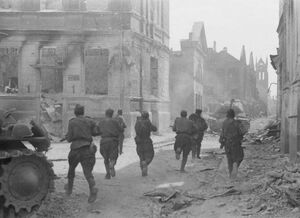
|
This Yellowstone: 1936 page is a Proposal.
It has not been ratified and is therefore not yet a part of the Yellowstone: 1936 Timeline. You are welcome to correct errors and/or comment at the Talk Page. If you add this label to an article, please do not forget to make mention of it on the Main Discussion page for the Timeline. |
| Second Russian Civil War Yellowstone: 1936 |
|||||||
|---|---|---|---|---|---|---|---|
 Soviet Troops Storming Kiev |
|||||||
|
|||||||
| Belligerents | |||||||
| Commanders and leaders | |||||||
| Strength | |||||||
| 2,450,000 | 4,350,000 | ||||||
| Casualties and losses | |||||||
| 436,401 Killed 765,340 Wounded | 645,872 Killed 1,019,394 Wounded |
||||||
The Second Russian Civil War was a civil conflict against the states of the Union of Soviet Socialist Republics and the nationalist Russian Republican Movement, led by Nikita Khrushchev and later by Leon Trotsky. After the war the Russian Federation was established by the Democratic - Republican movement, while the rest of the Soviet's territory became divided between several nations.
Background[]
During the later years of the Soviet Union, food was difficult to cultivate and/or scavenge in the far reaches of USSR. Most of the food produced within the Soviet Union came from the Southern Caucasus, Ukraine, and Central Asia. As national dissent grew, many begin to oppose the teachings and belief of Communism including people such Nikita Khrushchev and Leon Trotsky. This has started the creation of the Russian Democratic-Republic Movement led by Nikita Khrushchev.
In late 1941, much of the Red Army begin to defect and support the new Russian Democratic-Republican movement. As large defection continues, Stalin orders the suppression of external political parties, and the execution of any who defects from the Red Army and/or protest against the government. Mass executions begin to take place within the capital of Moscow, with mass graves being excavated at the city outskirts.
Violent protests soon begin to take place within the Soviet Union, destroying military barracks, and stealing weapons from local police stations, armories. On 1942 the Second Russian Civil War has begun when the Democratic-Republican movement revolted in the Leningrad Oblast. Thus sparking an armed insurrection across the Union of Soviet Socialist Republics.
Warfare[]
Siberia[]
Much of Siberia was quickly taken by the Democratic-Republican movement during the early stages of the conflict with ease; however, many were killed due to the cold and harsh environments of Siberia.
Leningrad Oblast[]
When the civil war begun, the armed insurrection quickly took over the district capital Leningrad and the surrounding area. Large groups of defectors from the Red Army joined the Democratic-Republican movement during the later stages of the battles in the districts.
Ukraine[]
The Red Army attempted to take absolute control the area during the beginning of the conflict. However, during military occupation farmers began to rebel against the Red Army, and went up in arms against the government. Local farmers and resistance groups along with some defectors from the Red Army soon stormed the city of Kiev, where the Red Army was the quickly defeated and the representatives from the Bolshevik party were later executed. Food was then supplied to other fronts of the war for the Democratic-Republican movement, as well as other supplies.
Byelorussia[]
Violent protests in the city of Minsk sparked local insurrection against the state and the Bolshevik party of the Soviet Union. Stalin ordered the Red Army to suppress the protests, but this later failed when the Red Army was pushed out of the city and soon surrendered.
Caucasus[]
Georgian, Azerbaijani, and Armenian supporters of the Russian Democratic-Republican movement quickly arose in the region shortly after the insurrection in the Leningrad Oblast. Rebels soon took over the Caucasus after the victory at Stalingrad, preventing the Red Army from mobilizing troops into the Caucasus from the Northeast and Northwest.
Central Asia[]
Muslim protesters soon stormed Red Army barracks and seized military supplies from armories which were sent to the main Russian front.
Russia[]
During the earlier years of the civil war, the Red Army were able to hold back the Democratic-Republican movement due to large amounts of supplies. However, with rebels taking over the Caucasus, Central Asia, and Ukraine many vital supplies such as oil and rations. In 1946 when most of the Soviet Union fell into the hands of the Democratic-Republican movement, most forces soon mobilized towards Moscow. The siege of Moscow lasted four months until rebels began to storm the defensive perimeter surrounding the city. The battle lasted for two more months until rebels stormed the Kremlin and hung Iosef Stalin in the Red Square.
| ||||||||||||||||||||
